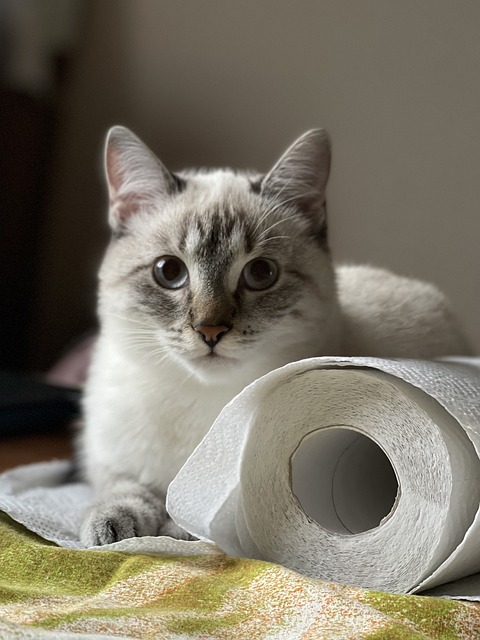Cats are seemingly everywhere (which makes sense considering there are at least 600 million cats in the world, 76.5 million pet cats in the United States, and that 29.7% of Minnesota households have at least one cat). They permeate popular culture, social media, and in many cases our homes.
Despite how ubiquitous cats are, we still have a long way to go to fully understand their behavior. We’re getting better at it as more people are realizing cats are really freakin’ cool and not just decorative pets, but the work still needs to be done. Unfortunately, part of what we’re realizing as we learn more about cats is that many of the things that have been considered normal for years are actually harmful to their wellbeing.
As someone who has studied cat behavior extensively and works with them professionally, I hear a lot of the myths that were once regarded as true still perpetuated. Most people mean well and don’t realize that what they’re talking about is not what we think currently about cats. I want to share some of the most common cat behavior myths and what cat behaviorists actually think is true.
Remember: there’s nothing to feel bad about if you believe any of these! Many of them were things I thought were true at one point as well.
Myth: Cats don’t need to go to the veterinarian unless they’re sick
Cats have a reputation for being an easier alternative to dogs (though this may come from the fact that we’re neglecting their needs) and many people don’t bring their cat to the veterinarian on a regular basis. In some cases, it’s because it can be challenging to bring a cat to the vet or get them into the carrier so it’s reserved for emergencies only. Many other cat parents see cats as being self-sufficient so they don’t require much care.
Regardless of reasoning, many cats go years without seeing a veterinarian. That’s been considered totally fine for years so it must be accurate!
Fact: Cats should be seen by a veterinarian at least every year
Regular veterinary care is incredibly important to your cat’s overall health. Many medical problems can be prevented or treated successfully with early intervention. Annual visits also give your veterinarian a chance to get to know your cat so they can monitor for changes over time. In other words, regular vet visits also mean more time with your sweet kitty!
For most adult cats, a yearly visit will suffice assuming there aren’t any urgent medical concerns. This is different for both kittens and senior cats. Kittens require monthly vet visits until they are four months of age, whereas senior cats should be seen every six months.
One of the top reasons people avoid the vet is because it can be challenging. In fact, 58% of cat owners say their cat hates trips to the vet! Thankfully, it doesn’t have to be a fight to get your cat the medical care they need. Seeking out a Fear Free Certified veterinarian or a Cat Friendly Practice will help you feel confident that your cat’s veterinarian will have the skills necessary to keep the visit as low stress as possible.
If you’re struggling with getting your cat in the carrier, consider leaving the carrier out all the time so it becomes a non-event when your cat needs to get in it. You can also consider using a pheromone spray to provide them with a sense of calm in the carrier or use silver vine powder to attract them inside. If you want more personalized advice, I’m available to help!
Myth: Cats can be left alone for the weekend without being checked on
As much as maintaining a litter box isn’t super fun, cats don’t need to be let out to use the restroom. That means no need to go outside during a cold Minnesota winter or when it’s blazing hot out, but it also means your cat can just be left home alone with plenty of food (or an automatic feeder), water, and a freshly scooped box, right?
Fact: Cats should not be left alone for more than 24 hours
In some cases, your cat may be okay being left alone for a while. However, leaving your cat alone isn’t great for their mental wellbeing. Cats need more stimulation and attention than what they typically get. By being left home for an extended period of time, they’ll be more likely to be bored and start finding ways to amuse themselves.
You will not like the ways they decide to amuse themselves.

Beyond the risk to your toilet paper and everything on your shelves, you are risking something serious happening to your cat and you not being able to do anything about it. Many medical problems, especially urinary blockages in male cats, can be rapidly fatal in cats if they are not treated by a veterinarian right away. If you’re gone for 3 days and your cat has a medical emergency, they may suffer needlessly or a treatable condition may become fatal. It’s not worth the risk.
Hiring a reliable, trustworthy petsitter is worthwhile. A great place to start if you’re local to Minneapolis or Minnesota is the Professional Pet Sitters of Minnesota.
Myth: Scruffing is a good way to restrain a cat because mother cats do it to their kittens
Scruffing is a way of holding a cat where they are grabbed by the skin on the back of their neck. It may be recommended in a variety of settings including when medicating a cat or trying to transport them a short distance. It used to be accepted as a gentle technique because kittens will be transported by adult cats by their scruff and it calms the kitten down while they are held by their scruff. Since kittens find scruffing calming, that means it must help calm adult cats!
Fact: Don’t scruff your cat
The logic behind scruffing your adult cat is flawed at it’s most basic level: Cats scruff their kittens until they are a few weeks old. When was the last time you saw a mother cat carrying around her adult offspring by the scruff?
I’ll wait.
It doesn’t happen. The whole premise of us scruffing cats as being gentle is flawed because it’s not actually a natural thing. It also has been shown in studies of handling techniques to not actually calm the cat down. In fact, it likely will make an adult cat more tense and agitated than they were to begin with.
Sadly, scruffing is still promoted by many people and used in some veterinary settings. There are much more effective and gentle handling techniques out there. If you are trying to medicate a cat, clip a cat’s nails, or do any other basic care technique for your cat, you can easily learn how to keep your cat calm without risking them ending up being in pain or fearful of you.
Myth: Cats can’t be trained
Some people think cats are aloof, distant creatures that just do whatever they want and never listen to us. Their behavior can’t change because they’re naughty and there’s no way they can learn to do anything we want them to do. They could never be trained to do cool tricks or useful behaviors like dogs.
Considering you’re on the blog of a professional cat trainer, I hope you know where this one is going.
Fact: You absolutely can train cats… and it’s fun!
Cats are actually very trainable. They’re really great at picking up on patterns so they will very quickly learn what gets them something they really want. In fact, you likely have trained your cat to do things you don’t want them to do by accidentally giving them attention. It’s one of the many reasons I don’t recommend using a squirt bottle to try to train your cat: the cat may think the squirt bottle is a fun game or like the attention from you. They may end up doing the behavior you’re trying to stop more. There are better ways that will actually work!
My favorite method of training cats is clicker training, though there are other ways that focus on teaching the cat what you want them to do rather than what you don’t want them to do. These methods, which try to increase wanted behaviors by giving the cats rewards for doing them, are called positive reinforcement based training methods.
Side note: One pet peeve of mine is when people call methods like squirt bottles, remote activated compressed air canisters, or even shock collars “negative reinforcement.” The term “negative reinforcement” actually refers to something that would increase a behavior. What people are talking about is actually positive punishment, meaning something is added and a behavior decreases.
Nerdy aside out of the way, what does training cats look like? Really anything you want it to! Cats can be trained to do almost any behavior they’re physically capable of doing, though more complex behaviors are going to be a bigger challenge. One of my favorite cat trainers is Melissa Millet of the Ultimutts. She trains cats for movies and TV shows. Her cats know how to do all sorts of cool things including riding on a scooter!
Interested in training your cat? A great place to start is the book The Trainable Cat. You can also consider getting a clicker training kit as many have a basic instruction manual on what to do. Otherwise, I offer cat training lessons if you want to work with a pro! We can go over training cats for fun or even work on training your cat to be a therapy cat.
Myth: If your cats are fighting, you should just let them figure it out
If your cats are fighting, chances are someone told you cats will just work it out if you just let them figure it out. After all, they’re cats and they’re pretty self sufficient. They’ll establish a hierarchy and one will dominate over the other. Surely you wouldn’t want to intervene!
Fact: You should intervene when cats are fighting
This one is a particularly bad idea. Letting your cats duke it out could potentially result in serious injuries. Cat bites can be dangerous to both humans and other cats as they can easily become infected. You absolutely want to break up a cat fight, but make sure you do so safely. In other words, don’t do anything that could escalate the situation by scaring them or putting your hands between them. Instead, put a physical barrier between the cats and gently guide one of them to a separate location.
You also need to think long term with fighting cats. Repeated fights will destroy their relationship, assuming there was a good one to begin with. Every time they fight, things get worse. Talk with your vet or a cat behaviorist about the best ways to get the cats to be able to live together. While not the ideal outcome, in some cases rehoming may end up being the safest and kindest thing to do.
Myth: All cat furniture is ugly and I don’t need any for my cats
Okay, okay. This myth isn’t directly about cat behavior, but it does directly affect cat behavior and harm cats. Let’s just round up and say it’s close enough, cool? Great, glad we’re on the same page.
Most people think of cat towers and they picture a carpeted monstrosity or they think of cat scratchers as being eyesores. Why would I want a giant piece of furniture in my living space for my cats that’s awful to look at?
Fact: There is a lot of really nice looking cat furniture out there (and you also NEED cat furniture)
I see a lot of behavior problems as a result of a lack of cat specific resources. As an example, people will have furniture that is scratched up but not a scratching post in sight. Not all behavior problems have an easy solution, but this happens to be one of them: an appropriately sized, sturdy scratching post in a good location.
I hate to be the bearer of bad news, but you absolutely need cat furniture if you have a cat. If you have multiple cats, you need even more cat furniture as interact conflict is often related to a lack of resources appropriate to the number of cats you have.
Thankfully, you don’t have to choose between a nice looking home and having a happy, well-behaved cat. As more people realize just how awesome cats are, there are more and more offerings for cat furniture that appeals to humans, too. Great brands to look at for nicer looking cat furniture include the Refined Feline and Catit. I actually have a cat tower from Catit right as you walk into my home! Etsy is another great place to look as you may be able to get custom made furniture that really fits in with your aesthetic.
While I have many more myths about cats and cat behavior I could go into, I promised you five so I’ll have to save the rest for another day. Remember, just because something has been accepted as normal for a long time doesn’t make it true!
Now go out and buy your cat a cat tree.










